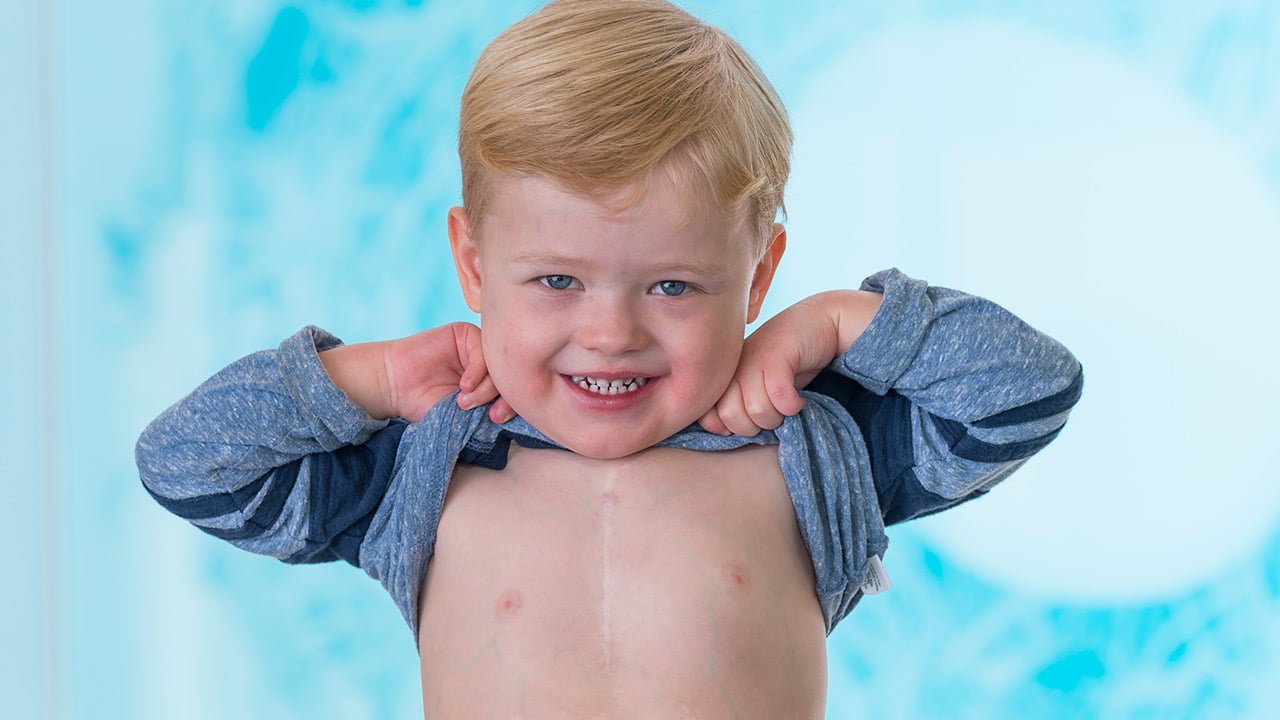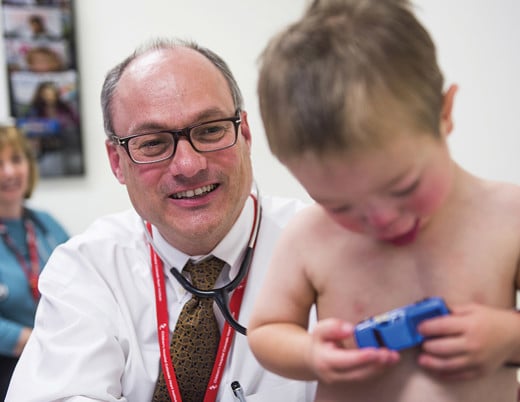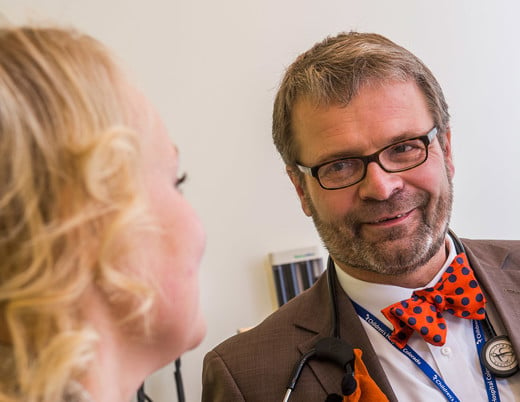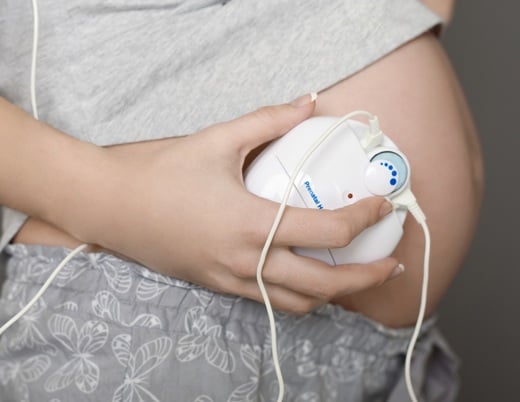Karla and Derick Senn got the diagnosis at 20 weeks: Their son, Jaden, had hypoplastic left heart syndrome, or HLHS, a rare and potentially devastating congenital heart defect.
With his left ventricle atrophied, only Jaden's right ventricle could pump blood — which could circulate through his body only as long as he was in the womb. Once he was born, once he needed to breathe, that would change.
He'd immediately need intensive care. Within days, he'd need the first of three major open heart surgeries: the Norwood. Over the next two years, he'd need two more — the Glenn and the Fontan — to fully harness his one working ventricle to do the job of two.
Karla and Derick were first-time parents. They couldn't wait to meet their son. But as Karla's due date approached, their anticipation mixed with fear.
"The last month was difficult," says Karla. "We were counting down to the time when our son was no longer going to be safe."
Building a stem cell patch that beats
At the Gates Center for Regenerative Medicine, a 10-minute walk across the Anschutz Medical Campus from Children's Hospital Colorado's main hospital, Jeff Jacot, PhD, with the University of Colorado Department of Bioengineering, is figuring out what's in a heart.
"Much of the material in organs is made up not of cells but of naturally occurring polymers that cells lay down," says Dr. Jacot. "Most of it's collagen, but there are a lot of other materials that reinforce and change its properties."
These polymers represent Dr. Jacot's basic canvas, produced essentially by removing the cells from an animal heart and dissolving what's left. This "ghost heart matrix," combined with synthetic materials, is the medium for his ultimate goal: using stem cells to engineer tissue that can seamlessly meld with a living heart.
He's surprisingly close to that goal. For a kid like Jaden, it's feasible — even likely — that tissue engineered in a lab like Dr. Jacot's will eventually become a part of his heart. What part, exactly, is hard to say.
The limitations of repairing heart defects with synthetics
Currently, pediatric congenital cardiothoracic surgeons like James Jaggers, MD, Co-Medical Director of the Heart Institute, use synthetic patches to reconstruct a variety of malformed heart structures.
"We've all been frustrated with the limitations of existing materials," Dr. Jaggers says. "These patches are made of either prosthetic or biologic tissue foreign to the patient, so the body reacts to them, and they create scars and promote clotting. And, because they cannot grow, the child may essentially outgrow them."
Harvesting amniotic stem cells for a patient's future
As soon as five years from now, Dr. Jacot says, doctors might start the process of heart engineering right at diagnosis of a condition like HLHS. Then and there, they could harvest a patient's own amniotic stem cells, which a lab could genetically manipulate to revert to their embryonic stage. They could then be induced to develop into the variety of cells that make up the heart: myocardial cells that contract and pump; endothelial cells that line blood vessels; smooth muscle cells that make them dilate or contract; fibroblast cells that maintain and repair the tissue; nerve cells that tell them all what to do.
Using a combination of 3D-printed synthetic materials and electrospinning — in which a cellular mix is drawn through a nozzle toward a spinning surface — the team could weave that matrix into a patch, or even a structure like a valve or an artery. A surgeon like Dr. Jaggers, Dr. Jacot's clinical partner, could then implant that structure to repair a defect like HLHS. As the patient's heart beat, it would beat. As the patient grew, it would grow.
All this technology already exists.
Dr. Jacot has already shown that a patch made of heart matrix outperforms synthetics in animal models — and that, over time, the heart's existing cells will invade the matrix, incorporating it into tissue. The next step is to test a patch with cells in place. That's in progress now.
In the meantime, Dr. Jacot says, "We're tuning in the right mix of chemicals, environmental factors, forces — anything that will influence the structure and development of heart tissue — to allow these cells to function the way they do in living children."
Searching out the best Fontan procedure outcomes
Karla and Derick did their homework. They asked their specialists for outcomes information, and when it wasn't forthcoming, they shopped around.
"We walked into a meeting with Children's Colorado and they handed us all their outcomes for that year and the last five years," Karla recalls. "Walking out to the car, we were like, 'This is where we're supposed to be.'"
At Children's Colorado, Jaden would have a roughly 90% chance of surviving the Norwood — significantly better than the 85% national average.* His chances rose to 99% for the Glenn, and effectively 100% for the Fontan.
Now 3 years old, Jaden had the Fontan last year.
"His energy levels are through the roof," Karla says. "He's barely stopped moving since."
Life with a single ventricle
But the energy comes at a price. Routing the body's entire blood-flow through the lungs increases pressure in the circuit. Over time, that pressure stresses the organs, particularly the liver. It taxes the heart, strains the kidneys, injures the brain, depletes the bones.
"Essentially these kids need to see everybody in the hospital," says pediatric cardiologist Michael Di Maria, MD, Co-Director of the Single Ventricle Care Program at Children's Colorado. "Ten or 15 years ago, we were all just trying to get these kids to live. We're no longer satisfied with that."
Diseases like HLHS are rare, and cardiology programs have typically referred complications of single-ventricle circulation to subspecialists as needed. These days, the Single Ventricle Care Program wraps in other specialties as soon as the Fontan circuit is complete: pediatric hepatology, pulmonology, psychology and even neuropsychology.
"Many of these kids have some degree of hypoxic white matter injury," says Kelly Wolfe, PhD, one of the few neuropsychologists in the nation specializing in kids with congenital heart disease. "We know the brains of kids with HLHS are different, starting in the third trimester of pregnancy, through adulthood."
Dr. Wolfe works with kids and families to assess for neurodevelopmental issues and to plan for the educational challenges that might result. Meanwhile, multidisciplinary partners like Deborah Liptzin, MD, the program's dedicated pulmonologist, and Michael Narkewicz, MD, its hepatologist, study comorbidities of Fontan circulation from new angles. Dr. Liptzin has identified higher rates of asthma in kids with Fontan circulation. Dr. Narkewicz is working to identify kids with more rapidly advancing liver fibrosis for earlier intervention.
Leading the way in single ventricle care research
In pursuit of deeper data still, pediatric cardiologist Adel Younoszai, MD, the Single Ventricle Care Program's other Co-Director, is developing partnerships around the world.
"In adult medicine, the cardiac population is in the hundreds of thousands," he says. "Here, we've got a couple of hundred kids, but compared to 20 or 30, that's huge. If we can connect with 10 other institutions, we're talking 2,000 patients. Now we can learn as a group."
These groups are amassing long-term data that's changing the course of treatment. Where once doctors advised kids on the Fontan circuit to avoid straining it with exercise, for example, the data now clearly shows active kids achieve better long-term outcomes. Collaborations among institutions have led to trials of drugs to help with exercise tolerance, which programs like the Adult Congenital Heart Disease Program at Children's Colorado can use to help even older patients live longer, healthier lives.
"I think of this quote from Desmond Tutu," says Dr. Younoszai. "'There comes a point when we need to stop just pulling people out of the river. We need to go upstream and find out why they're falling in.'"
A foundation of Fontan wellness and support
On the second and fourth Tuesday of any given month, a half-dozen kids with congenital heart disease are wandering the labyrinth embedded in the floor of Children's Colorado's atrium, looking for hearts.
They're on a scavenger hunt built into their clinic day at the Single Ventricle Care Program — later, they'll visit Seacrest Studios, home of the hospital's patient radio station, and the helipad.
While they explore the hospital under the guidance of child psychologist Sarah Kelly, PsyD, Clinical Director of the Heart Institute Wellness Program, and child life specialist Megan Fisher, CCLS, their medical team reviews their cases. Meanwhile, over coffee and bagels, their parents chat.
"The Wellness Program connected us with another family before Jaden was born, and that mom has since introduced me to a group of heart moms who are just incredible women," says Karla. "It was such a source of comfort. If I was having a panic moment or just didn't understand what was going on, that parent perspective was so helpful."
Now active in the Single Ventricle Care Program's parent community, Karla has herself become a source of comfort for families newly diagnosed. That's exactly what Dr. Kelly hopes for. The purpose of the Wellness Program, she says, is to connect families to resources — including each other.
"These families can go through significant trauma," she says. "I think it's common in medicine to look for risks and defects. We're looking for areas of strength and resilience: what they do well, how and why they do it well, and how we can harness and promote those strengths."
Shifting the paradigm of Fontan procedure care
The process starts with looking forward — not only to the comorbidities and complications kids like Jaden will face, but to the future of their care.
"For 30 years there hasn't been any real technological change to how these defects are repaired," says Dr. Jacot. "I think regenerative medicine is going to be that change."
Within Jaden's lifetime, Dr. Jacot's work may produce radical capabilities today's innovators are only beginning to conceive. Dr. Younoszai envisions a beating sub-heart that could pump blood out of the liver to relieve congestion. Dr. Jaggers imagines rebuilding entire chambers of the heart.
"It's exciting, but I think the most important thing is that it's giving families hope," says Dr. Younoszai. "I don't have all the answers for them, but I can give them hope."
* National average provided by the Society of Thoracic Surgeons.
Featured Researchers

Jeff Jacot, PhD
Associate professor
Bioengineering
University of Colorado - Denver

James Jaggers, MD
Co-Medical Director, Heart Institute
Children's Hospital Colorado
Barton-Elliman Chair in Pediatric Cardiothoracic Surgery, Surgery-Cardiothoracic
University of Colorado School of Medicine
Michael Di Maria, MD
Pediatric cardiologist
Children's Hospital Colorado
Associate professor
Pediatrics-Cardiology
University of Colorado School of Medicine

Kelly Wolfe, PhD
Director, Cardiac Neurodevelopmental Program
The Neuroscience Institute
Children's Hospital Colorado
Associate professor
Pediatrics-Neurology
University of Colorado School of Medicine

Michael Narkewicz, MD
Pediatric hepatologist
Digestive Health Institute
Children's Hospital Colorado
Professor
Pediatrics-Gastroenterology, Hepatology and Nutrition
University of Colorado School of Medicine
Adel Younoszai, MD
Cardiologist
The Heart Institute
Children's Hospital Colorado

Sarah Kelly, PsyD
Director, Heart Institute Wellness Program
The Heart Institute
Children's Hospital Colorado
Associate professor
Pediatrics-Cardiology
University of Colorado School of Medicine





 720-777-0123
720-777-0123










